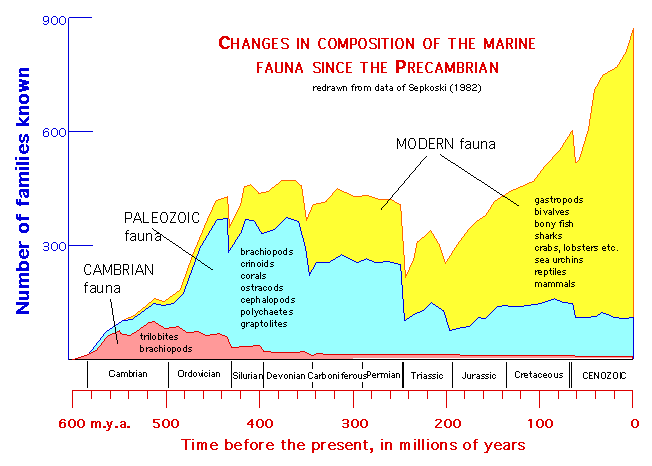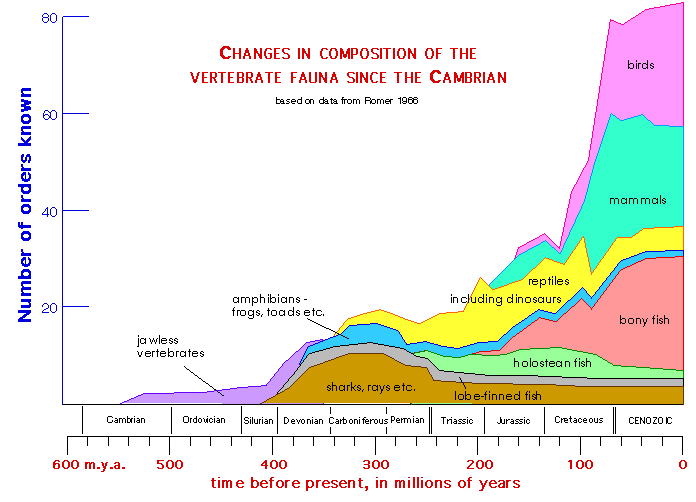|
|
| Biology 284a
: Patterns in Life's Diversity
a synoptic overview ©Paul Handford 2000 |
|---|
Our key to comprehending
all this complexity is the recognition that:
|
|
The evolutionary process involves both
Some of the conditions to which life adapts
are:
sizes range
from:
BACTERIA CAN DO EVERYTHING EVERYWHERE |
compared to them, all eukaryotes
are metabolically very limited
see Lecture Notes chap. 3.
are based on their inferred closeness of EVOLUTIONARY
RELATIONSHIPS - the recency of their common ancestors.
Traditionally, this involved consideration of characteristics of gross form & of function, and, not long ago, most organisms were considered to be either:
PLANTS or ANIMALS
largely on the basis of whether they photosynthesised or not,
but now, through the use of tools such as the electron microscope and DNA/RNA sequence analysis, we have access to a more diverse set of characteristics, and their careful analysis has revealed a different & clearer picture of the evolutionary relationships among life's forms -
so that now, all life is divided into several kingdoms rather than being forced into two artificial groups.
Exactly how many kingdoms there
should be is a matter of much current debate, which need not concern us
here;
the central point is that, regardless
of how many kingdoms there are, these groups now much more closely reflect
the true evolutionary
relationships among organisms, rather than reflecting superficial similarities
- such as being green.
In this course, we shall be looking at life with the framework provided by the
this system first separates life into:
Prokaryotes (Bacteria or Monera)
and
Eukaryotes(organisms with nuclei and other organelles)
and then further reduces the eukaryotes into
Protoctists
Below is a figure showing the evolutionary relationships among all of earth's biota. Identified there are the five kingdoms (the Bacteria or Monera turn out to include two distinctive clusters of forms - here referred to as Bacteria and Archaea).
Note the diversity of UNfamiliar forms as compared to the closeness of the forms with which we are most familiar.
See also L.N. 1.5 showing the development of eukaryote structure from prokaryotes by endosymbiosis.
|
|
|
NOW ON TO THE QUESTION OF THEIR NUMBERS |
the answer depends on what kinds you count: species; families; classes; phyla.............. most species are insects
Here are some pie-diagrams which induicate the ways in which the
various groups break down by sumbers of species. For further detail,
please see the Lecture notes, Chapter 8.
Altogether, we see that the earth's biota is dominated by life forms with which most of us are not familiar. Our own kind does not provide a good yardstick for taking the true measure of life on earth.
|
|

First we see the marine record, which includes a diversity of unfamiliar animals, many now extinct, along with a good number which are still around today. Notice the rapid growth of the biota during the Cambrian and Ordovician periods, then a more or less steady-state until the end of the Permian (about 250 m.y.a.). At that time there took place the greatest extinction the world has eyt experienced. SInce that time, the marine fauna has become progressively more diverse up to the present.

Next we see the vertebrate record, which largely includes forms familiar to most of us. Until mid-Devonian, all vertebrates were aquatic, but slowly, terrestrial forms diversified, spectacularly so in the Mesozoic (Triassic, Jurassic & Cretaceous); this was the time of the rise of the reptiles. Birds, bony fish and mammals originated back in the Triassic and Jurassic, but began an enormous rise to their present prominence at the end of the Cretaceous, coinciding with the end of the dinosaur dominance of terrestrial habitats.
a football field of paces takes us back to the start of agriculture;
a walk from Fairbanks, Alaska to Miami, Florida would take us to the origins of multicellular life;
a great-circle flight from N.Y. to Perth, Australia would take us to the origins of eukaryotes
TO REACH LIFE'S ORIGINS would take us past N.Y, and most of the
way back to Perth again.
Another way to gain some impression of the vastness of time, especially
as compared to the times with which we have some familarity, is to represent
all the time since earth's origins in a circle, and break that circular
pie into segments according to their durations:
To expand upon this initial picture, see pp. 8 & 9 in Introductory materials and the detailed Time-charts.
|
|
therefore, where they are now depends on where & when they originated and how the global geography has changed since then ..............
Our understanding of the earth's past geography has changed radically in recent time, leading to a greatly-improved understanding of the geographical distribution of organisms.
their passenger biotic lineages thus may evolve, depending on circumstances,
at times in isolation, when they have undisputed access to some restricted part of the globe;
at other times they may gain access to wider geographic areas and become exposed to other evolving lineages
these opportunities for protected diversification and/or expansion + competition lie behind some profound irregularities in the geographical distribution of kinds of organisms. This is the topic of biogeography.
see L.N. 11.4, 5 & 6, showing continental drift and biogeographic realms.
For further description of the basics of organismal geography, click here.
On the net, see this excellent site, which provides a series of plate-tectonic reconstructions to show the broad patterns of Phanerozoic Earth history (the last 600 million years or so).
in this course we shall look simply atpatterns in 'species richness' -the number of species in any given group in any specified region
species richness depends on both the geographical location and the size of the region.
In general, species richness increases towards the equator:
species richness is also positively related to the area considered.
It is not simply a matter of latitude or area, however; it is also profoundly affected by rainfall, among other things......... see L.N. 8 & 9.
what are the qualitative, evolutionary-adaptive responses of the biota to climate?
we find that, to some extent, the different evolutionary lineages that are found in the different continental regions respond in similar adaptive ways to major features of global climate which may span several continents, generating major adaptive assemblages recognised as biomes.
These biomes are recognisable as such because the general appearance of their prominent organisms is very much the same, even though those organisms often derive from very different evolutionary lineages.
Biomes include such major assemblages as arctic tundra, boreal forest, deserts, grasslands and rainforests.
This system of BIOMES is the final global biotic pattern which we shall illustrate.
see L.N. 12 for global climate, and the rest of the Lecture Notes for the ways that the biota responds to it.